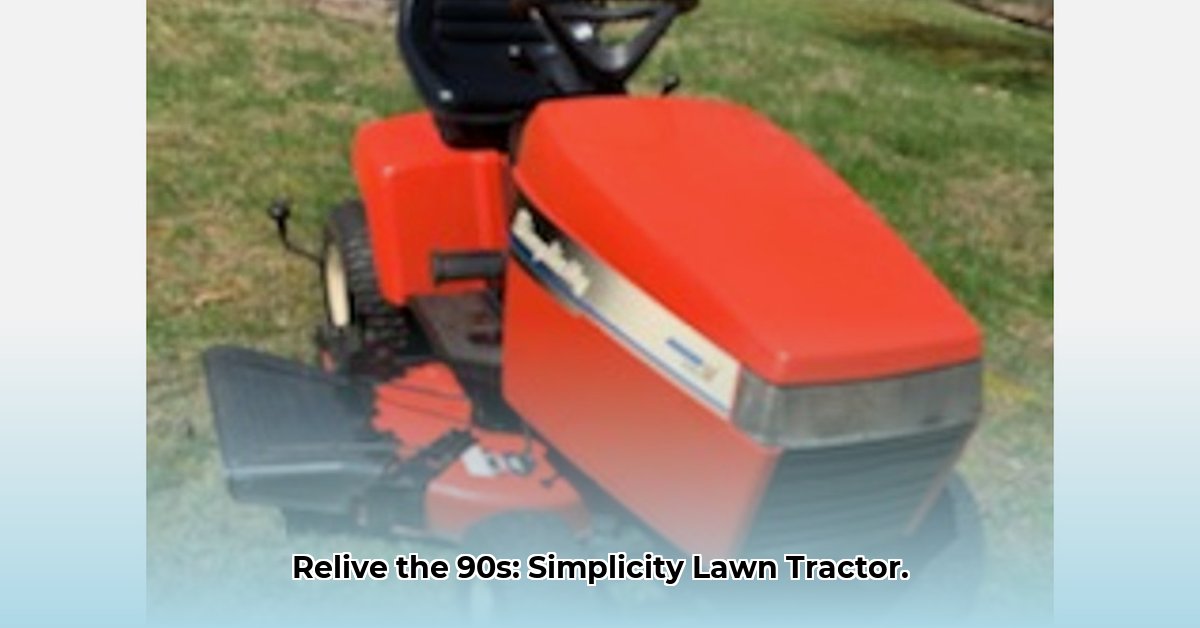
The 1995 Simplicity lawn tractor—a name synonymous with dependable yard work. But this machine wasn't just a tool; it represented a significant era in lawn care technology. For more on other lawn tractors, check out this helpful resource. This article delves into the history, features, and legacy of the 1995 Simplicity Sovereign 18H (or similar model year variants), exploring its place within the broader lawn tractor market of the mid-1990s.
The Lawn Tractor Landscape of the Mid-1990s
Imagine 1995: the internet was in its infancy, dial-up reigned supreme, and suburban backyards were the silent battlegrounds of a lawn care arms race. John Deere, Toro, and Simplicity held sway, each vying for a place in the American garage. Simplicity distinguished itself by focusing on robust, user-friendly machines. They weren’t flashy, but they emphasized dependability and longevity. The 1995 Simplicity lawn tractor perfectly exemplified this approach. Did this focus on reliability pay off in terms of long-term customer satisfaction? We'll explore that later.
Unveiling the 1995 Simplicity Sovereign 18H
The 1995 Simplicity, frequently a Sovereign 18H model, was less about cutting-edge technology and more about getting the job done. It was the dependable workhorse of the backyard. The satisfying hum of the engine, the smooth, even cut – it was a straightforward, rewarding experience. Beneath the hood, you’d find a robust engine (though the horsepower might seem modest by today's standards). The transmission, likely a belt-driven system, was a reliable technology of the time. The cutting deck design was pivotal to its efficient performance; precise specifications varied slightly based on the sub-model. Consulting the original owner's manual is crucial for precise details.
Performance and User Experience: A Retrospective
Finding in-depth 1995 performance reviews is a challenge. However, anecdotal evidence suggests the 1995 Simplicity excelled in reliability and ease of maintenance. Was it the fastest tractor? No. But its straightforward design made repairs manageable for mechanically inclined owners. The machine prioritized function over flash. Its simple controls and manageable size contributed to its user-friendliness. In its unassuming simplicity, it truly shined. A common refrain from owners at the time was "it just worked."
Comparing the 1995 Simplicity to Its Rivals
Let's compare the 1995 Simplicity Sovereign 18H to its competitors:
| Feature | 1995 Simplicity Sovereign 18H | Competitors (e.g., John Deere, Toro) |
|---|---|---|
| Engine Horsepower | Varied by sub-model; check your manual. | Similar range, often higher HP options available. |
| Cutting Deck Size | Varied by sub-model; check your manual. | Similar size options, with varied designs. |
| Transmission | Belt-driven | Belt-driven or hydrostatic drive options. |
| Price | Mid-range (historical pricing varies) | Wide range of prices; premium features often increased cost. |
Remember, specific specifications and pricing varied across sub-models.
The Simplicity Lineup and its Enduring Legacy
The 1995 Sovereign 18H occupied Simplicity's mid-range. While not top-of-the-line, it offered considerable value. It embodied Simplicity's design philosophy: dependable, straightforward machines built to last. This approach fueled their reputation for durability. While not frequently seen in active use today, the 1995 Simplicity is gaining traction among collectors who appreciate its rugged simplicity and old-school charm.
Conclusion: A Testament to Simple Reliability
The 1995 Simplicity lawn tractor wasn't revolutionary, but it excelled at its core function: dependable, affordable performance. It embodies a time when quality trumped flash, a legacy appreciated by many even today. Sometimes, true simplicity is the best approach.
How Did Simplicity Lawn Tractor Engine Specifications Evolve From 1993-1997?
The mid-1990s witnessed significant shifts in the lawn tractor market. Simplicity, known for its quality, was at the forefront of these changes. This section analyzes the evolution of Simplicity's engine specifications between 1993 and 1997; a period marked by steady iterative improvements rather than revolutionary leaps. The emphasis remained on dependable, durable construction, a core value for the brand.
Engine Technology and Simplicity's Approach
Simplicity lawn tractors of this era generally relied on robust, air-cooled engines, frequently employing cast iron construction for superior durability. While not as fuel-efficient as modern counterparts, they were designed for long-term reliability. Improvements focused on enhancing existing technology—refining air-cooling, tweaking fuel delivery, and optimizing engine longevity. The goal wasn't radical power increases, but rather incremental improvements to already dependable designs.
Simplicity's Engine Choices: A Closer Look
Precise engine specifications across all Simplicity models from 1993-1997 necessitate deep archival research. However, a common feature was the use of Briggs & Stratton engines, reflecting a long-standing partnership. These engines usually fell within the 16-18 horsepower range—suitable for residential lawn care.
Likely Trends (1993-1997):
- Gradual Power Increases: Minor boosts in horsepower were likely implemented over this period.
- Engine Refinements: Focus on improved air-cooling, fuel delivery, and overall reliability.
- Transmission Advancements: Potential improvements to Simplicity's hydrostatic or belt-driven transmission systems.
Beyond engine improvements, consider other key advancements:
- Cutting Deck Enhancements: Improved designs for wider cuts or efficient airflow.
- Operator Comfort Improvements: More comfortable seats, ergonomic controls.
- Added Features: Headlights, improved attachments, etc.
The evolution of Simplicity's lawn tractors during this period reflects a commitment to iterative improvement rather than radical innovation, an approach that built a reputation for longevity and reliability.